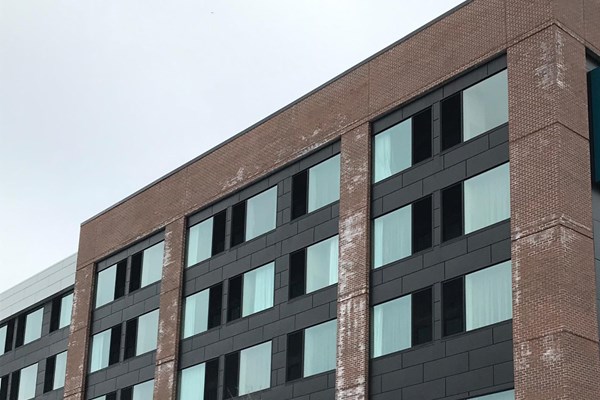
Unless you work in construction, you may not be familiar with the word “efflorescence”. While it may sound like something to do with toothpaste, efflorescence describes a problem that has long plagued the masonry segment of the construction industry. The American Concrete Institute describes efflorescence this way:
“Efflorescence is a deposit of salts, usually white, formed on a surface, the substance having emerged in solution from within either concrete or masonry and subsequently been precipitated by the reaction, such as carbonation, or evaporation.”
While the average person doesn’t know what efflorescence is, most of us have seen it. Buildings with brick exteriors that appear to have a fine, white crystalline powder on the surface of the masonry are examples of efflorescence, which can also show up as a brown, green, or yellow stain on masonry surfaces.
Causes of Efflorescence
Efflorescence happens when water reacts or mixes with masonry materials to move salts to the surface of the masonry element. The masonry wall must contain three elements for efflorescence to occur: soluble salts, water, and a force to move the dissolved salts to the exterior of the wall.
The soluble salts could be present in the brick, mortar ingredients, grout, water, contacting soils, or windborne chemicals and dust. The salts could also be created as a result of a reaction between these elements or embedded conduits and reinforcing.
Exposure to moisture (water) through rainfall or high humidity affects the potential for efflorescence. The more water present, the more salt can be dissolved. The absorption and porosity of the masonry product used (e.g. brick) may also have an impact.
Temperature can be a force impacting efflorescence, affecting both the speed of water movement in the wall, as well as the location of evaporation. Because they receive more sun and become hotter, south- and west-facing walls allow moisture evaporation to move further into the wall, thereby minimizing efflorescence. The north- and east-facing walls are commonly cooler, allowing for water within the walls to move to the surface before it evaporates. On these faces, the salts would be transported to the surface and would exhibit more efflorescence.
Preventing Efflorescence
While all masonry elements are susceptible to efflorescence, controlling the amount of water in the system (and thereby reducing the amount of solution available to dissolve the salt) is the most effective way to prevent efflorescence. Good construction techniques, including full head joints, correctly installed wall drainage components, and covering of unfinished walls during construction, all serve to minimize water infiltration. Water repellants are another option that not only prevents water infiltration but can also reduce the rate of evaporation and slow down the migration of salts to the surface.
Masonry materials should be selected with the least amount of salts. Low-alkali cement and washed sands should be used, as well as use clean, potable water that is free of acids, alkalis, and salts. Masonry materials should be stockpiled on pallets above the ground. Additionally, use mortars with proven resistance to efflorescence and select caulking and sealant materials that are compatible with the masonry. Furthermore, consider flashing, weep holes, and air vents in areas where water can accumulate. Landscape, sprinkling systems, and downspouts should also be placed appropriately to avoid splashback.
At Cleveland Construction, we believe that minimizing efflorescence can be best achieved through a thoughtful approach to the design and construction of masonry elements on projects. Careful collaboration and planning with Design Teams, Manufacturers, and Trade Partners are key to solving this multi-faceted problem.